Answered step by step
Verified Expert Solution
Question
1 Approved Answer
PHOTOGRAPHY GETTY IMAGES How I Did It... Tsingtao's Chairman On Jump-Starting a Sluggish Company by Jin Zhiguo THE IDEA Western executives may complain that
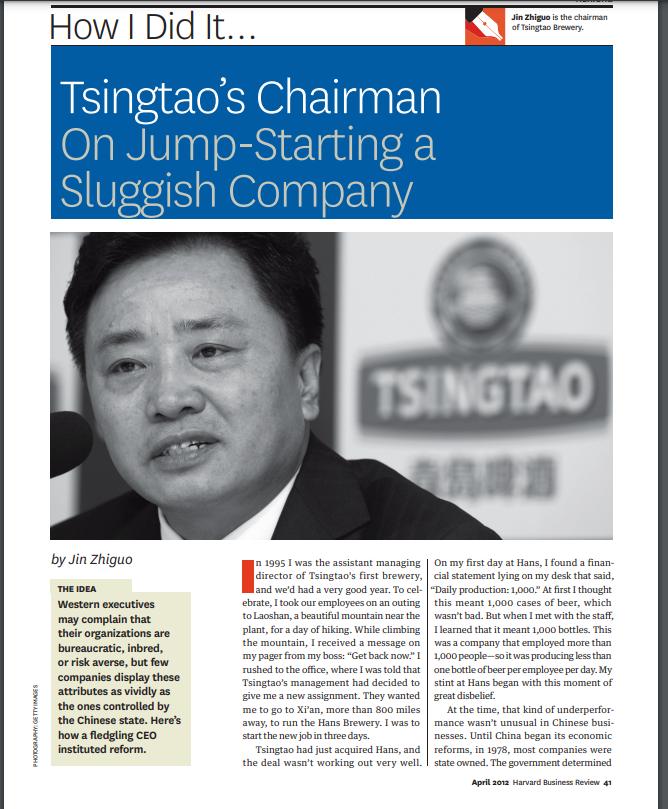
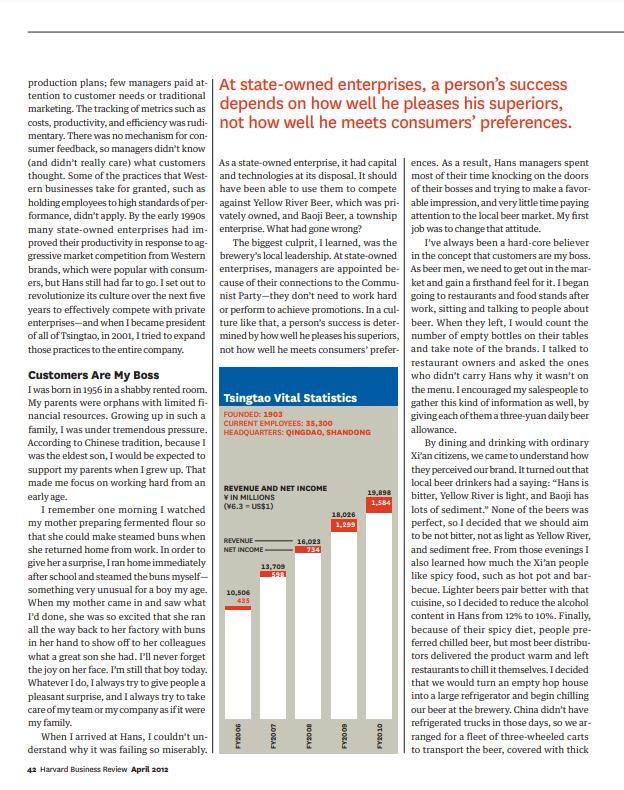
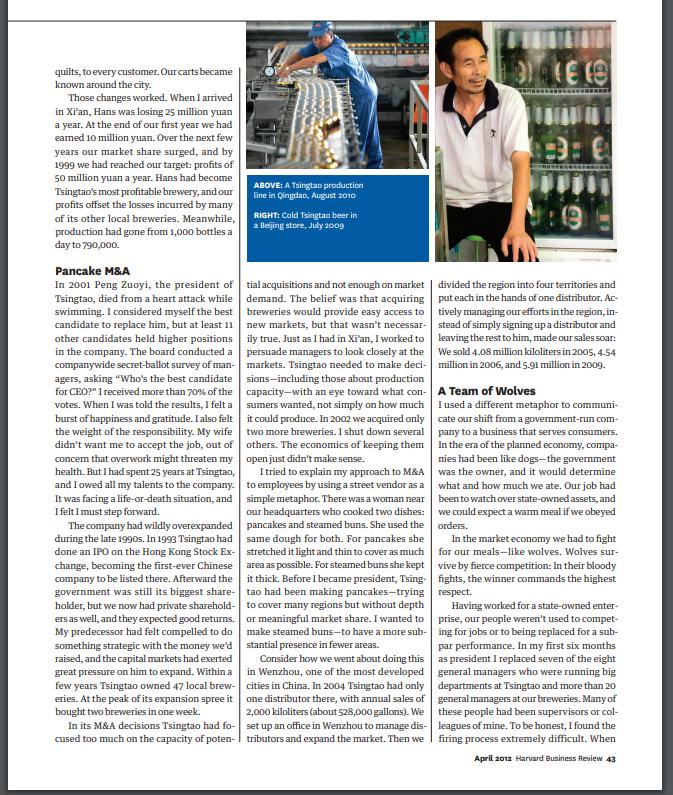
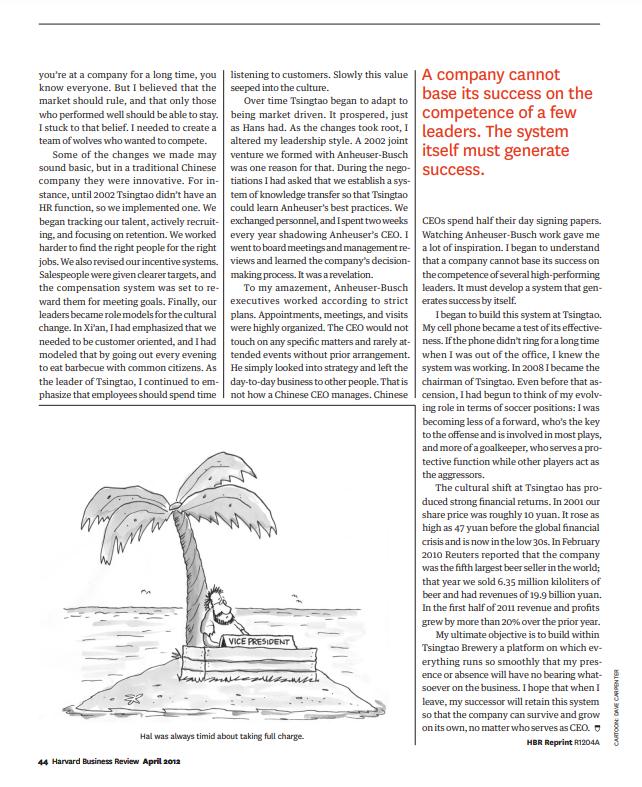
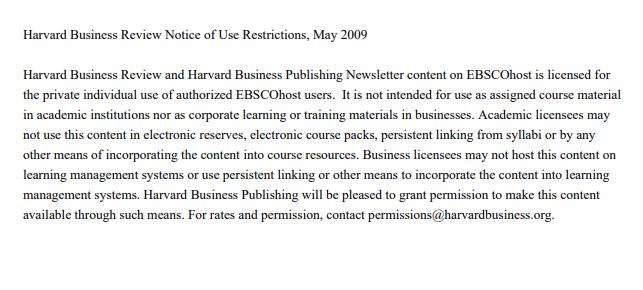
PHOTOGRAPHY GETTY IMAGES How I Did It... Tsingtao's Chairman On Jump-Starting a Sluggish Company by Jin Zhiguo THE IDEA Western executives may complain that their organizations are bureaucratic, inbred, or risk averse, but few companies display these attributes as vividly as the ones controlled by the Chinese state. Here's how a fledgling CEO instituted reform. TSINGTAO In 1995 I was the assistant managing director of Tsingtao's first brewery, and we'd had a very good year. To cel- ebrate, I took our employees on an outing to Laoshan, a beautiful mountain near the plant, for a day of hiking. While climbing the mountain, I received a message on my pager from my boss: "Get back now." I rushed to the office, where I was told that Tsingtao's management had decided to give me a new assignment. They wanted me to go to Xi'an, more than 800 miles away, to run the Hans Brewery. I was to start the new job in three days. Jin Zhiguo is the chairman of Tsingtao Brewery. Tsingtao had just acquired Hans, and the deal wasn't working out very well. On my first day at Hans, I found a finan- cial statement lying on my desk that said, "Daily production: 1,000." At first I thought this meant 1,000 cases of beer, which wasn't bad. But when I met with the staff, I learned that it meant 1,000 bottles. This was a company that employed more than 1,000 people-so it was producing less than one bottle of beer per employee per day. My stint at Hans began with this moment of great disbelief. At the time, that kind of underperfor- mance wasn't unusual in Chinese busi- nesses. Until China began its economic reforms, in 1978, most companies were state owned. The government determined April 2012 Harvard Business Review 41 production plans; few managers paid at-| At state-owned enterprises, a person's success tention to customer needs or traditional marketing. The tracking of metrics such as costs, productivity, and efficiency was rudi- mentary. There was no mechanism for con- sumer feedback, so managers didn't know (and didn't really care) what customers thought. Some of the practices that West- ern businesses take for granted, such as holding employees to high standards of per- formance, didn't apply. By the early 1990s any state-owned enterprises had im- proved their productivity in response to ag- gressive market competition from Western brands, which were popular with consum- ers, but Hans still had far to go. I set out to revolutionize its culture over the next five years to effectively compete with private enterprises and when I became president of all of Tsingtao, in 2001, I tried to expand those practices to the entire company. depends on how well he pleases his superiors, not how well he meets consumers' preferences. As a state-owned enterprise, it had capital | ences. As a result, Hans managers spent and technologies at its disposal. It should most of their time knocking on the doors have been able to use them to compete of their bosses and trying to make a favor- against Yellow River Beer, which was pri-able impression, and very little time paying vately owned, and Baoji Beer, a township enterprise. What had gone wrong? attention to the local beer market. My first job was to change that attitude. The biggest culprit, I learned, was the brewery's local leadership. At state-owned enterprises, managers are appointed be- cause of their connections to the Commu- nist Party-they don't need to work hard or perform to achieve promotions. In a cul- ture like that, a person's success is deter- mined by how well he pleases his superiors, not how well he meets consumers' prefer- I've always been a hard-core believer in the concept that customers are my boss. As beer men, we need to get out in the mar- ket and gain a firsthand feel for it. I began going to restaurants and food stands after work, sitting and talking to people about beer. When they left, I would count the number of empty bottles on their tables and take note of the brands. I talked to restaurant owners and asked the ones who didn't carry Hans why it wasn't on the menu. I encouraged my salespeople to gather this kind of information as well, by giving each of them a three-yuan daily beer allowance. Customers Are My Boss I was born in 1956 in a shabby rented room. My parents were orphans with limited fi- Tsingtao Vital Statistics nancial resources. Growing up in such a family, I was under tremendous pressure. According to Chinese tradition, because I was the eldest son, I would be expected to support my parents when I grew up. That made me focus on working hard from an early age. I remember one morning I watched my mother preparing fermented flour so that she could make steamed buns when she returned home from work. In order to give her a surprise, I ran home immediately after school and steamed the buns myself- something very unusual for a boy my age. When my mother came in and saw what I'd done, she was so excited that she ran all the way back to her factory with buns in her hand to show off to her colleagues what a great son she had. I'll never forget the joy on her face. I'm still that boy today. Whatever I do, I always try to give people a pleasant surprise, and I always try to take care of my team or my company as if it were my family. When I arrived at Hans, I couldn't un- derstand why it was failing so miserably. 42 Harvard Business Review April 2012 FOUNDED: 1903 CURRENT EMPLOYEES: 35,300 HEADQUARTERS: QINGDAO, SHANDONG REVENUE AND NET INCOME VIN MILLIONS (V6.3 -US$1) REVENUE NET INCOME 10,506 435 13,709 598 16,023 734 18,026 1,299 19,898 1,584 By dining and drinking with ordinary Xi'an citizens, we came to understand how they perceived our brand. It turned out that local beer drinkers had a saying: "Hans is bitter, Yellow River is light, and Baoji has lots of sediment." None of the beers was perfect, so I decided that we should aim to be not bitter, not as light as Yellow River, and sediment free. From those evenings I also learned how much the Xi'an people like spicy food, such as hot pot and bar- becue. Lighter beers pair better with that cuisine, so I decided to reduce the alcohol content in Hans from 12% to 10%. Finally, because of their spicy diet, people pre- ferred chilled beer, but most beer distribu- tors delivered the product warm and left restaurants to chill it themselves. I decided that we would turn an empty hop house into a large refrigerator and begin chilling our beer at the brewery. China didn't have refrigerated trucks in those days, so we ar- ranged for a fleet of three-wheeled carts to transport the beer, covered with thick quilts, to every customer. Our carts became known around the city. Those changes worked. When I arrived in Xi'an, Hans was losing 25 million yuan a year. At the end of our first year we had earned 10 million yuan. Over the next few years our market share surged, and by 1999 we had reached our target: profits of 50 million yuan a year. Hans had become Tsingtao's most profitable brewery, and our profits offset the losses incurred by many of its other local breweries. Meanwhile, production had gone from 1,000 bottles a day to 790,000. Pancake M&A In 2001 Peng Zuoyi, the president of Tsingtao, died from a heart attack while swimming. I considered myself the best candidate to replace him, but at least 11 other candidates held higher positions in the company. The board conducted a companywide secret-ballot survey of man- agers, asking "Who's the best candidate for CEO?" I received more than 70% of the votes. When I was told the results, I felt a burst of happiness and gratitude. I also felt the weight of the responsibility. My wife didn't want me to accept the job, out of concern that overwork might threaten my health. But I had spent 25 years at Tsingtao, and I owed all my talents to the company. It was facing a life-or-death situation, and I felt I must step forward. The company had wildly overexpanded during the late 1990s. In 1993 Tsingtao had done an IPO on the Hong Kong Stock Ex- change, becoming the first-ever Chinese company to be listed there. Afterward the government was still its biggest share- holder, but we now had private sharehold- ers as well, and they expected good returns. My predecessor had felt compelled to do something strategic with the money we'd raised, and the capital markets had exerted great pressure on him to expand. Within a few years Tsingtao owned 47 local brew- eries. At the peak of its expansion spree it bought two breweries in one week. In its M&A decisions Tsingtao had fo- cused too much on the capacity of poten- ABOVE: A Tsingtao production line in Qingdao, August 2010 RIGHT: Cold Tsingtao beer in a Beijing store, July 2009 13) ( (9 put each in the hands of one distributor. Ac- tively managing our efforts in the region, in- stead of simply signing up a distributor and leaving the rest to him, made our sales soar: We sold 4.08 million kiloliters in 2005, 4.54 million in 2006, and 5.91 million in 2009. tial acquisitions and not enough on market | divided the region into four territories and demand. The belief was that acquiring breweries would provide easy access to new markets, but that wasn't necessar- ily true. Just as I had in Xi'an, I worked to persuade managers to look closely at the markets. Tsingtao needed to make deci- sions-including those about production capacity-with an eye toward what con- sumers wanted, not simply on how much it could produce. In 2002 we acquired only two more breweries. I shut down several others. The economics of keeping them open just didn't make sense. I tried to explain my approach to M&A to employees by using a street vendor as a simple metaphor. There was a woman near our headquarters who cooked two dishes: pancakes and steamed buns. She used the same dough for both. For pancakes she stretched it light and thin to cover as much area as possible. For steamed buns she kept In the market economy we had to fight for our meals-like wolves. Wolves sur- vive by fierce competition: In their bloody it thick. Before I became president, Tsing-fights, the winner commands the highest tao had been making pancakes-trying respect. to cover many regions but without depth or meaningful market share. I wanted to make steamed buns-to have a more sub-ing stantial presence in fewer areas. A Team of Wolves I used a different metaphor to communi- cate our shift from a government-run com- pany to a business that serves consumers. In the era of the planned economy, compa- nies had been like dogs-the government was the owner, and it would determine what and how much we ate. Our job had been to watch over state-owned assets, and we could expect a warm meal if we obeyed orders. Having worked for a state-owned enter- prise, our people weren't used to compet- for jobs or to being replaced for a sub- par performance. In my first six months Consider how we went about doing this as president I replaced seven of the eight in Wenzhou, one of the most developed general managers who were running big cities in China. In 2004 Tsingtao had only departments at Tsingtao and more than 20 one distributor there, with annual sales of general managers at our breweries. Many of 2,000 kiloliters (about 528,000 gallons). We these people had been supervisors or col- set up an office in Wenzhou to manage dis-leagues of mine. To be honest, I found the tributors and expand the market. Then we firing process extremely difficult. When April 2012 Harvard Business Review 43 you're at a company for a long time, you listening to customers. Slowly this value | A company cannot seeped into the culture. know everyone. But I believed that the market should rule, and that only those Over time Tsingtao began to adapt to who performed well should be able to stay. being market driven. It prospered, just base its success on the competence of a few leaders. The system I stuck to that belief. I needed to create a team of wolves who wanted to compete. as Hans had. As the changes took root, I altered my leadership style. A 2002 joint Some of the changes we made may venture we formed with Anheuser-Busch itself must generate was one reason for that. During the nego- Success. tiations I had asked that we establish a sys- tem of knowledge transfer so that Tsingtao could learn Anheuser's best practices. We exchanged personnel, and I spent two weeks every year shadowing Anheuser's CEO. I went to board meetings and management re- views and learned the company's decision making process. It was a revelation. sound basic, but in a traditional Chinese company they were innovative. For in- stance, until 2002 Tsingtao didn't have an HR function, so we implemented one. We began tracking our talent, actively recruit- ing, and focusing on retention. We worked harder to find the right people for the right jobs. We also revised our incentive systems. Salespeople were given clearer targets, and the compensation system was set to re- ward them for meeting goals. Finally, our leaders became role models for the cultural change. In Xi'an, I had emphasized that we needed to be customer oriented, and I had modeled that by going out every evening to eat barbecue with common citizens. As the leader of Tsingtao, I continued to em- phasize that employees should spend time To my amazement, Anheuser-Busch executives worked according to strict plans. Appointments, meetings, and visits were highly organized. The CEO would not touch on any specific matters and rarely at- tended events without prior arrangement. He simply looked into strategy and left the day-to-day business to other people. That is not how a Chinese CEO manages. Chinese Janne VICE PRESIDENT 44 Harvard Business Review April 2012 Hal was always timid about taking full charge. CEOs spend half their day signing papers. Watching Anheuser-Busch work gave me a lot of inspiration. I began to understand that a company cannot base its success on the competence of several high-performing leaders. It must develop a system that gen- erates success by itself. I began to build this system at Tsingtao. My cell phone became a test of its effective- ness. If the phone didn't ring for a long time when I was out of the office, I knew the system was working. In 2008 I became the chairman of Tsingtao. Even before that as- cension, I had begun to think of my evolv- ing role in terms of soccer positions: I was becoming less of a forward, who's the key to the offense and is involved in most plays, and more of a goalkeeper, who serves a pro- tective function while other players act as the aggressors. The cultural shift at Tsingtao has pro- duced strong financial returns. In 2001 our share price was roughly 10 yuan. It rose as high as 47 yuan before the global financial crisis and is now in the low 30s. In February 2010 Reuters reported that the company was the fifth largest beer seller in the world; that year we sold 6.35 million kiloliters of beer and had revenues of 19.9 billion yuan. In the first half of 2011 revenue and profits grew by more than 20% over the prior year. My ultimate objective is to build within Tsingtao Brewery a platform on which ev- erything runs so smoothly that my pres- ence or absence will have no bearing what- soever on the business. I hope that when I leave, my successor will retain this system so that the company can survive and grow on its own, no matter who serves as CEO. HBR Reprint R12044 CARTOON DAVE CARPENTER Harvard Business Review Notice of Use Restrictions, May 2009 Harvard Business Review and Harvard Business Publishing Newsletter content on EBSCOhost is licensed for the private individual use of authorized EBSCOhost users. It is not intended for use as assigned course material in academic institutions nor as corporate learning or training materials in businesses. Academic licensees may not use this content in electronic reserves, electronic course packs, persistent linking from syllabi or by any other means of incorporating the content into course resources. Business licensees may not host this content on learning management systems or use persistent linking or other means to incorporate the content into learning management systems. Harvard Business Publishing will be pleased to grant permission to make this content available through such means. For rates and permission, contact permissions@harvardbusiness.org.
Step by Step Solution
★★★★★
3.59 Rating (145 Votes )
There are 3 Steps involved in it
Step: 1
The Role Strategic Leadership Plays in Achieving a Competitive Advantage Introduction The relationship between strategic leadership and its role in achieving competitive advantage has been a topic of ...
Get Instant Access to Expert-Tailored Solutions
See step-by-step solutions with expert insights and AI powered tools for academic success
Step: 2

Step: 3

Ace Your Homework with AI
Get the answers you need in no time with our AI-driven, step-by-step assistance
Get Started


